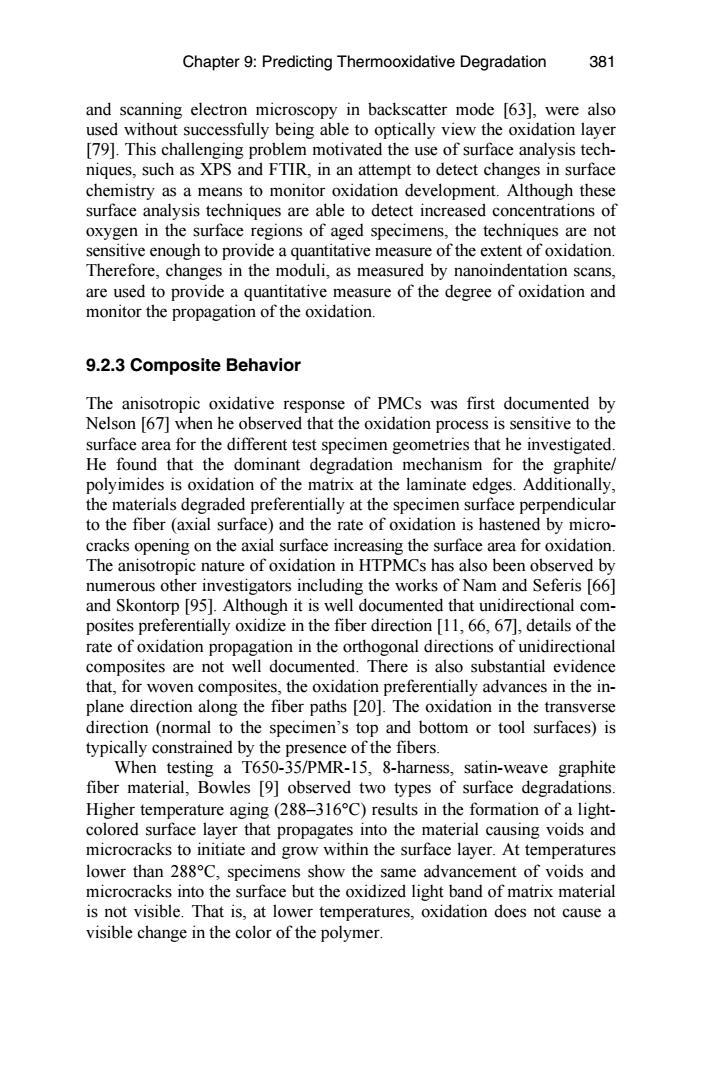正在加载图片...

Chapter 9:Predicting Thermooxidative Degradation 381 and scanning electron microscopy in backscatter mode [631,were also used without successfully being able to optically view the oxidation layer [79].This challenging problem motivated the use of surface analysis tech- niques,such as XPS and FTIR,in an attempt to detect changes in surface chemistry as a means to monitor oxidation development.Although these surface analysis techniques are able to detect increased concentrations of oxygen in the surface regions of aged specimens,the techniques are not sensitive enough to provide a quantitative measure of the extent of oxidation. Therefore,changes in the moduli,as measured by nanoindentation scans, are used to provide a quantitative measure of the degree of oxidation and monitor the propagation of the oxidation. 9.2.3 Composite Behavior The anisotropic oxidative response of PMCs was first documented by Nelson [67]when he observed that the oxidation process is sensitive to the surface area for the different test specimen geometries that he investigated He found that the dominant degradation mechanism for the graphite/ polyimides is oxidation of the matrix at the laminate edges.Additionally, the materials degraded preferentially at the specimen surface perpendicular to the fiber(axial surface)and the rate of oxidation is hastened by micro- cracks opening on the axial surface increasing the surface area for oxidation The anisotropic nature of oxidation in HTPMCs has also been observed by numerous other investigators including the works of Nam and Seferis [66] and Skontorp [95].Although it is well documented that unidirectional com- posites preferentially oxidize in the fiber direction [11,66,671,details of the rate of oxidation propagation in the orthogonal directions of unidirectional composites are not well documented.There is also substantial evidence that,for woven composites,the oxidation preferentially advances in the in- plane direction along the fiber paths [20].The oxidation in the transverse direction (normal to the specimen's top and bottom or tool surfaces)is typically constrained by the presence of the fibers. When testing a T650-35/PMR-15,8-harness,satin-weave graphite fiber material,Bowles [9]observed two types of surface degradations. Higher temperature aging(288-316C)results in the formation of a light- colored surface layer that propagates into the material causing voids and microcracks to initiate and grow within the surface layer.At temperatures lower than 288C,specimens show the same advancement of voids and microcracks into the surface but the oxidized light band of matrix material is not visible.That is,at lower temperatures,oxidation does not cause a visible change in the color of the polymer.and scanning electron microscopy in backscatter mode [63], were also used without successfully being able to optically view the oxidation layer [79]. This challenging problem motivated the use of surface analysis techniques, such as XPS and FTIR, in an attempt to detect changes in surface chemistry as a means to monitor oxidation development. Although these surface analysis techniques are able to detect increased concentrations of oxygen in the surface regions of aged specimens, the techniques are not sensitive enough to provide a quantitative measure of the extent of oxidation. Therefore, changes in the moduli, as measured by nanoindentation scans, are used to provide a quantitative measure of the degree of oxidation and monitor the propagation of the oxidation. 9.2.3 Composite Behavior The anisotropic oxidative response of PMCs was first documented by Nelson [67] when he observed that the oxidation process is sensitive to the surface area for the different test specimen geometries that he investigated. He found that the dominant degradation mechanism for the graphite/ polyimides is oxidation of the matrix at the laminate edges. Additionally, the materials degraded preferentially at the specimen surface perpendicular to the fiber (axial surface) and the rate of oxidation is hastened by microcracks opening on the axial surface increasing the surface area for oxidation. The anisotropic nature of oxidation in HTPMCs has also been observed by numerous other investigators including the works of Nam and Seferis [66] and Skontorp [95]. Although it is well documented that unidirectional composites preferentially oxidize in the fiber direction [11, 66, 67], details of the rate of oxidation propagation in the orthogonal directions of unidirectional composites are not well documented. There is also substantial evidence that, for woven composites, the oxidation preferentially advances in the inplane direction along the fiber paths [20]. The oxidation in the transverse direction (normal to the specimen’s top and bottom or tool surfaces) is typically constrained by the presence of the fibers. When testing a T650-35/PMR-15, 8-harness, satin-weave graphite fiber material, Bowles [9] observed two types of surface degradations. Higher temperature aging (288–316°C) results in the formation of a lightcolored surface layer that propagates into the material causing voids and microcracks to initiate and grow within the surface layer. At temperatures lower than 288°C, specimens show the same advancement of voids and microcracks into the surface but the oxidized light band of matrix material is not visible. That is, at lower temperatures, oxidation does not cause a visible change in the color of the polymer. Chapter 9: Predicting Thermooxidative Degradation 381